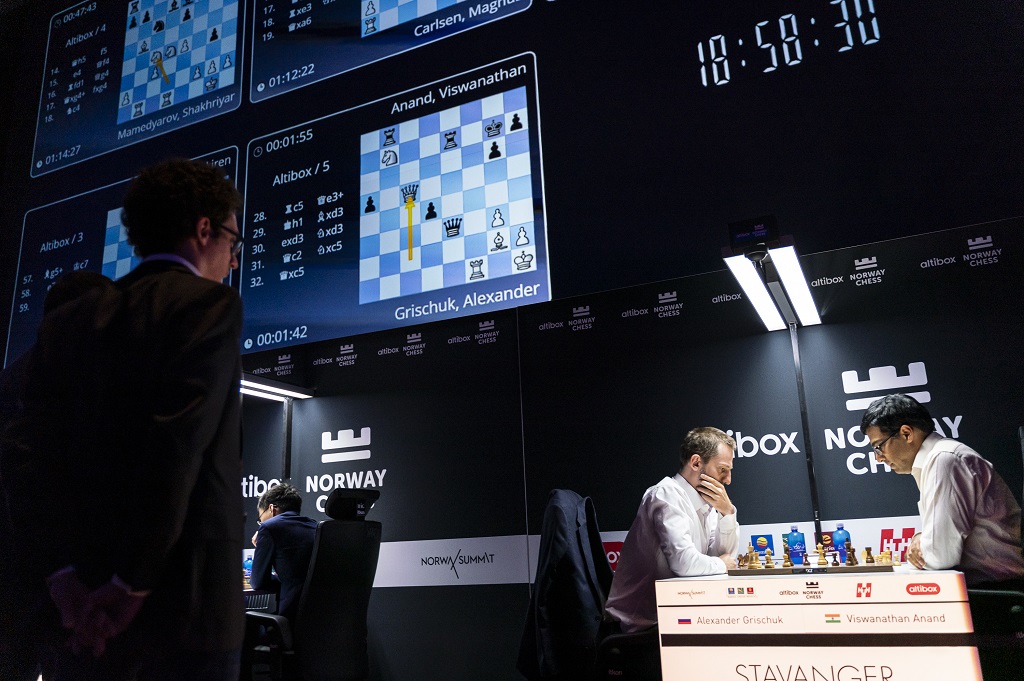


After seven rounds, Magnus Carlsen was the clear leader in Stavanger, but somehow it did not feel like he was dominating by as big a margin as the one shown in the standings table. It had all to do with the fact that the Norwegian had amassed most of those points by winning match-ups in Armageddon. After all, Ding Liren was the one with a '+2' score in Classical — Carlsen, Aronian and So were on '+1'. However, in round eight, the world champion proved he is still number one by taking down Yu Yangyi in their two-hour-per-side encounter, thus winning the tournament with a round to spare.
The fact that this is a 'mixed event', with games played in different time controls, is particularly fitting for Magnus, who has won all six tournaments he has participated in this year (now including Norway Chess) — and his seventh straight triumph if we count his first place at the World Blitz Championship in Saint Petersburg.
Carlsen has now won 7 straight tournaments:
— Tarjei J. Svensen (@TarjeiJS) 13 de junio de 2019
🏆 Norway Chess
🏆 Lindores Abbey
🏆 Abidjan GCT
🏆 Grenke Chess Classic
🏆 Shamkir Chess
🏆 Wijk aan Zee
🏆 World Blitz Ch.
The Tata Steel Masters, the Gashimov Memorial and the GRENKE Classic were all 'regular' classical events, but Magnus also got first places at a Blitz event (World Blitz Championship), a Rapid tournament (Lindores Abbey) and a Rapid & Blitz competition (Abidjan Grand Chess Tour). Given these precedents, it makes sense that Carlsen won in Stavanger, under a format that is rather difficult to define properly — almost-Classical/Armageddon perhaps?
Leaving the formal definitions aside, no matter the format, this year it almost seems impossible for Magnus Carlsen not to get first place in any given tournament.

Magnus Carlsen arriving in the venue with his long-time second Peter Heine Nielsen | Photo: Lennart Ootes
In addition, like Tarjei J. Svensen also mentioned in his twitter account, Magnus has not lost a classical game in 319 days (by Friday), with his win over Yu Yangyi hitting a rather irrelevant yet illustrative milestone: he tied Wesley So's streak of 67 classical games without a loss from 2015-17. If the Norwegian goes 33 more games without a defeat, he will tie Ding Liren's 100-game streak, which ended last November.
Finally, besides trying to keep up the pace in Classical, Carlsen will surely try to recover first place atop the Blitz ratings list in the coming tournaments, a spot that is currently in Maxime Vachier-Lagrave's hands, after the Frenchman defeated Carlsen in three consecutive blitz encounters.

Number one in the blitz ratings — Maxime Vachier-Lagrave | Photo: Lennart Ootes
The first place in Stavanger was decided solely in Classical, as the only player that could have caught up with Carlsen after the world champion defeated Yu Yangyi was Levon Aronian, but the Armenian lost with the white pieces against Fabiano Caruana.
The local hero in Stavanger used the positional style that helped him climb to the top the elite in years past, getting a slight edge out of the opening and making the most of his pawn majority on the queenside with opposite-coloured bishops on the board:
.jpg)
The lowest rated player in Stavanger, Yu Yangyi, is having a good tournament despite his round eight loss | Photo: Lennart Ootes
In the meantime, Aronian was trying to create winning chances against Caruana, but in order to do so he weakened his king's position. The 2018 World Championship challenger kept playing accurately, though, and when he felt he was the one with chances against the opposite king, he did not shy away from opening up the position:
Fabiano decided it was time to move forward with 32...e4, and Levon blundered after 33.fxe4 ♞e5 34.♗d1 fxe4:
White needed to opt for 35.♘g4 instead of 35.♗e2 — the idea is that, in the game, after 35...♞f3+ 36.♗xf3 ♜xf3 37.♕xb6, Black had 37...♛f6 creating a battery on the f-file while defending the bishop...a possibility he would not have had with the white knight on g4.
From this point on, White's queen, rook and bishop coordinated a strong attack that pushed Aronian to resign on move 41.

Fabiano Caruana taking a look at his colleagues' games | Photo: Lennart Ootes
Other than the previously mentioned decisive classical games, the longest draw of the day lasted 46 moves (Mamedyarov v So). Both Maxime Vachier-Lagrave and Alexander Grischuk did not push for long despite having the white pieces and transferred the battle to the quick-paced sudden death deciders.
When deciding to sign a 20-move draw in the Classical, perhaps Vachier-Lagrave took into account the fact that Ding Liren has been so far showing bad results in Armageddon (the Chinese had lost four mini-matches in that stage prior to round eight). In the deciding blitz game, the players reached a rarely seen endgame:
Here, Ding Liren should have kept his rook in an active square instead of going for 34...♜a2 — standing next to its own pawn, the rook's mobility is hampered. Nonetheless, it is not at all simple to convert this position to a win with White. Maxime, however, showed good technique and ended up getting the 1½ points of the mini-match after 59 moves. The complete game:

Also number one in France — Maxime Vachier-Lagrave | Photo: Lennart Ootes
In Grischuk v Anand, the Russian, who is having a tough time in Norway, gave up a pawn on move 12, taking the game into a highly complicated middlegame. Although the computers assessed the position as balanced (leaning towards giving White the edge), it seemed easier to handle it from the black side. In the midst of a complex struggle, Grischuk faltered by capturing a pawn, and Vishy did not let his chances go to waste:
With 29...♝xd3 Anand forced some simplifications that favoured the presence of his passer on the d-file — the game continued 30.exd3 ♞xd3 31.♕c2 ♞xc5 32.♕xc5 d3 and the passer was the reason Grischuk resigned eight moves later.

Alexander Grischuk v Vishy Anand | Photo: Lennart Ootes
Finally, for a third time in Stavanger, Wesley So drew both his games with Black to get 1½ points at the end of the day. His victim in round eight was Shakhriyar Mamedyarov, who has collected 5½ points so far and is in ninth place, only above Grischuk. Both games to replay:

The ever friendly Wesley So signing an autograph | Photo: Lennart Ootes
GM Danny King recaps the action from round five
| # | Name | Country | Rating | Points |
| 1 | Magnus Carlsen | Norway | 2875 | 13 |
| 2 | Levon Aronian | Armenia | 2752 | 9 |
| 3 | Yu Yangyi | China | 2738 | 8½ |
| 4 | Wesley So | USA | 2754 | 8½ |
| 5 | Fabiano Caruana | USA | 2819 | 8½ |
| 6 | Ding Liren | China | 2754 | 8 |
| 7 | Maxime Vachier-Lagrave | France | 2779 | 7½ |
| 8 | Viswanathan Anand | India | 2767 | 7½ |
| 9 | Shakhriyar Mamedyarov | Azerbaijan | 2774 | 5½ |
| 10 | Alexander Grischuk | Russia | 2775 | 4 |